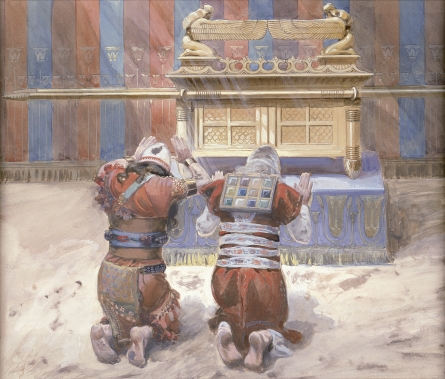Moses and Joshua bowing before the Ark, painting by James Jacques Joseph Tissot, c. 1900
What did the Ark of the Covenant look like?
Let's look at the description given in Exodus 25:10-20:
Verse 10:
- It is called an "ark:" (Heb. ארון - "A box: - ark, chest, coffin." Strong's Concordance).
- It was made of acacia wood.
- The dimensions were: "Two and a half cubits long and a cubit and a half wide and a cubit and a half high." A cubit was approximately 20 inches long.
Verse 11:
- It was overlain "with pure gold" inside and out.
- There was some kind of crown or molding around the outside of it.
Verse 12:
- There were 4 gold rings - one attached to each of its four feet.
Verse 13-15:
- Poles of acacia wood overlain with gold were inserted through the rings for the purpose of carrying it.
Verse 17:
- There was a lid or covering often translated as "mercy seat" (Heb. כפרת - kapporeth. "A lid [used only of the cover of the sacred Ark]: - mercy seat." Strong's Concordance).
- The dimensions of the mercy were two and a half cubits by one and a half cubits.
- On top of the "mercy seat" there were two cherubim on each end.
Verse 20:
- The wings of the cherubim "covered" (Heb. סָכַךְ - sakak. "to entwine as a screen; by implication to fence in, cover over, [figuratively] protect: - cover, defence, defend, hedge in, join together, set, shut up." Strong's Concordance) the "mercy seat".
- The faces of the cherubim faced one another toward the "mercy seat".
The "Mercy Seat"
The description of the ark is fairly straightforward until we come to the description of the kapporeth (mercy seat). The word "kapporeth" shares its root with kaphar (כָּפַר) which means "to cover" or "to atone" in the sense of hiding or covering up sin. The Hebrew name of the "mercy seat" then does not make it clear that the kapporeth was a seat.
However, despite the ambiguity of the description in Exodus 25 it is clear from elsewhere in the Bible that the kapporeth was indeed a seat or throne of some kind.
1 Samuel 4:4 and 2 Samuel 6:2, in reference to the Ark, describe the Lord "dwelling between the cherubim". The word "dwelling" is translated from yashab (יָשַׁב) which can also be translated as "to sit down as in judgement". In addition, multiple prophets have seen in vision the heavenly temple wherein the Lord was enthroned in the Holy of Holies (see Isaiah 6:1; Ezekiel 10:1 and 1 Nephi 1:8).
The description of the ark is fairly straightforward until we come to the description of the kapporeth (mercy seat). The word "kapporeth" shares its root with kaphar (כָּפַר) which means "to cover" or "to atone" in the sense of hiding or covering up sin. The Hebrew name of the "mercy seat" then does not make it clear that the kapporeth was a seat.
However, despite the ambiguity of the description in Exodus 25 it is clear from elsewhere in the Bible that the kapporeth was indeed a seat or throne of some kind.
1 Samuel 4:4 and 2 Samuel 6:2, in reference to the Ark, describe the Lord "dwelling between the cherubim". The word "dwelling" is translated from yashab (יָשַׁב) which can also be translated as "to sit down as in judgement". In addition, multiple prophets have seen in vision the heavenly temple wherein the Lord was enthroned in the Holy of Holies (see Isaiah 6:1; Ezekiel 10:1 and 1 Nephi 1:8).
The "Cherubim"
The cultural proximity of the Israelites and Canaanites was very close. In fact it has been argued that "Israelite religion [was] a subset of Canaanite religion." (See Peterson, Nephi and His Asherah, Journal of Book of Mormon Studies: Volume - 9, Issue - 2, Pages: 16–25 Provo, Utah: Maxwell Institute, 2000). As a result we can get a pretty good idea of how the Israelites may have depicted the cherubim on the ark by looking at Canaanite representations of cherubim.
Pictured below is the sarcophagus of Ahiram who was the king of Byblos around the time of King David. Interestingly he is depicted sitting atop a cherubic throne toward the left side of the photo and it is likely the Ark of the Covenant looked similar in some respects to this throne.
Below is another depiction of a cherub throne found on an ivory from Megiddo dating to approximately 1200 BC.
Interestingly, in Egypt we find examples of portable thrones carried on poles just as the Ark of the Covenant was. Below is an image of Ramesses III (ca. 1182-1151 BC) on a portable throne from Medinet Habu.
Therefore, by studying the description of the Ark in the Bible and by examining other ancient examples of portable cherub thrones we can develop a pretty good idea of what the Ark of the Covenant looked like.




No comments:
Post a Comment